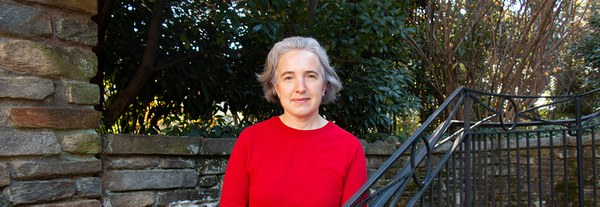Samantha L. Martin, associate professor of architecture at University College Dublin, was a Mellon History Teaching Fellow in fall 2021. Her research report, “Designing for Dissent: Democracy, Urbanism, and the Mediation of Conflict,” discusses the reciprocity between urbanism and democracy, especially how the ancient agora of Athens accommodated dissent.
Q&A with Samantha L. Martin
What was the role of the agora in classical antiquity?
Today we mainly think of the agora as the civic center of ancient Athens, but of course there were agoras throughout the ancient Greek world. Although each agora was architecturally distinct, most agoras shared certain physical characteristics, all the while prioritizing congregation and assembly. The noun agora is derived from the verb ἀγείρω (ageirô), which primarily means “to gather together.” Greek agoras were not walled or fenced, though they were carefully bounded. They were demarcated by boundary stones, or horoi—horos means “boundary” in Greek. Horismos—where we get the word “horizon”—was the idea of a linear space that can change and is attuned to what lies beyond a boundary or limit. Buildings also contributed to bounding the agora, but they framed the space in a way that engaged viewpoints and gazes between buildings in the agora and beyond. So, while there were limits on who could enter the agora and when, the boundary was not something that divided but rather announced the presence of a limit.
How does this relate to our understanding of democracy and dissent?
Rethinking agoras as bounded but permeable and inhabited spaces can have a profound effect on the way we appraise civic space more widely. We tend to visualize civic spaces from the top-down, almost with a godlike omniscience, but this is a completely modern, post-Enlightenment way of seeing. Rather, it is crucial to consider how we engage with and negotiate boundaries on the ground, in person. Democracy as practiced in ancient Athens and elsewhere was the physical act of gathering in a bounded place. Of paramount importance was participating in the common realm, including the acknowledgment of differences through speech and sight.
Today, we seek to banish discord from cities, constructing physical as well as metaphorical walls, and we have lost the significance that conflict brings to an urban environment, especially within the context of democracy. The Greeks understood that agon (ἀγών), meaning “dissent” or “contest”—where we get our English terms “agony” and “agonize”—was essential to maintaining civic order, and the agora was the ground where conflict was reconciled. This perspective helps us ask better questions about how our cities work now.
This approach also inverts our idea of the relationship between democracy and the urban landscape: we first need to consider and evaluate how people participate in the public sphere and then design our civic centers to accommodate and facilitate engagement. Democracy is fundamentally related to how people interact with one another, and where they do that is important but not driven by the buildings themselves. Instead, landscape is the medium that embodies democratic practice. In Washington, DC, for example, it’s treacherous to ascribe democratic ideals to the architecture; the Founding Fathers knew very little about the buildings associated with democracy in classical Athens—these structures were not systematically excavated until the twentieth century.The symbolism of DC’s architecture was almost manufactured to suit the federal and civic and political ambition of the early United States, and this has had deep, long-lasting ramifications. We need to call time on idolizing only certain aspects of the classical tradition in the United States.
As a Mellon History Teaching Fellow, you have been rethinking the pedagogy of urban landscapes. How does this research reshape the way you teach about cities?
I’ve had very fruitful and affirming conversations with director of Garden and Landscape Studies Thaïsa Way, which is really the reason I’m here—to talk to people about their own cities. Conversations with the other fellows in the Mellon Initiative in Urban Landscape Studies has also been fantastic because we’re all working on notions of conflict and unrest in a way.
In my class, we look at the civic spaces of Dublin, where I teach, and I’m thinking of also looking at other cities with civic squares of historic importance, like Beijing’s Tiananmen Square, to see how conflict is made manifest. Tahrir Square in Cairo is another good example—it is in the heart of the city and is flanked by important institutions, such as the Arab League Headquarters. Even in Washington, DC, the National Mall was not designed to accommodate conflict but rather it began as a bucolic ideal, and the privilege to protest there had to be fought for by Black Americans. Overall, the key idea here is to use the agora to ask more trenchant questions about how civic spaces are contested today, how layers of history contribute to how these spaces are used, and how the spaces accommodate conflict (or don’t).
May Wang is postgraduate writing and reporting fellow. Photo by Emily Orr, humanities fellow.

